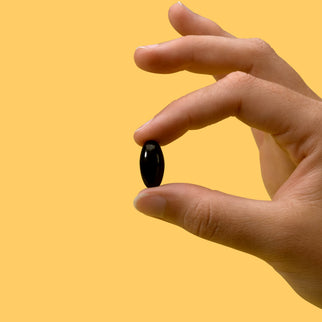Canned tuna is an easy go-to when you need a quick meal, but it may have more to offer than just convenience. This convenient canned fish provides a hefty list of nutrients, including protein and healthy fats.
Offering both DHA and EPA omega-3s, canned tuna is a good source of these essential nutrients — but there are other factors to consider as well. Before you turn to canned tuna as your go-to source for omega-3 fatty acids, you should weigh the pros and cons that come with it.
What Is Omega-3?
Omega-3s are a type of polyunsaturated fatty acid found in cells throughout the body. These fatty acids are important as they make up the building blocks of cell membranes. As a key part of cell membranes, omega-3 fats can influence how cells interact with each other, which means that they can have a strong influence on supporting and regulating several bodily functions.
There are three main types of omega-3s, which are:
- Alpha-linolenic acid (ALA), an omega-3 precursor
- Docosahexaenoic acid (DHA)
- Eicosapentaenoic acid (EPA)
The most important omega-3s to obtain are DHA and EPA, because they offer the most health benefits and are less common in a standard diet. The body can convert some ALA into DHA and EPA, but only in very small amounts, meaning that you need to supplement them through your diet.
The most popular way to obtain DHA and EPA is through marine sources, like fish, but few people consume enough fish to get their recommended 250-500 mg per day of these two fatty acids. Because these two essential fats are harder to find in a standard diet, you must be extra mindful about incorporating them into your daily nutrition.
What Are the Benefits of Omega-3?

Because of its role in building and influencing cells in the body, omega-3 can support overall cell function. As a result, consuming omega-3s offers many potential health benefits by supporting several important bodily systems. Some of the possible benefits of consuming omega-3s include:
- Supporting heart health
- Helping to maintain a healthy blood pressure
- Supporting healthy cholesterol levels
- Supporting healthy cognitive function throughout aging, like memory and motor function
- Helping to support healthy joint function through aging
- Supporting a positive mood and emotional wellness
Is Canned Tuna a Good Source of Omega-3?
Although the omega-3 content can vary depending on your serving, canned tuna is a rich source of essential DHA and EPA fatty acids. On average, one serving of canned tuna provides anywhere from 100 to over 900 mg of combined DHA and EPA fatty acids.
When compared to the recommended daily intake of 250-500 mg, this average can either be just under or well above the body’s necessary amounts. Still, tuna can be considered an excellent source of DHA and EPA omega-3s compared to most others.
Tuna has a list of other benefits in addition to being a good source of omega-3. For starters, the canned fish is packed with protein, offering as much as 20 grams in just one serving. On top of its protein content, canned tuna also has considerable amounts of other important nutrients, like vitamin D, calcium, iron, selenium, and potassium.
Not only is canned tuna rich in omega-3 and other nutrients, but it is also convenient. On a tight schedule, it is much easier to open a can of tuna to get your daily intake of DHA and EPA omega-3s than to bake another type of fish. Plus, a can of tuna is much cheaper. Still, these benefits may be too good to be true when looking at the bigger picture.
Are There Risks to Eating Canned Tuna?

There are several nutritional benefits to eating canned tuna, but they, unfortunately, can come at a price, so you need to be informed before adding canned tuna to your diet. By being mindful of your intake, you can mitigate some of the risks.
As a predator in the ocean that eats other fish, tuna has a much higher mercury content than other fish. Consuming mercury comes with several risks and can be harmful to the nervous system, especially in children. Experts have even recommended limits on how often children should eat tuna due to the harmful effects of the toxic metal.
However, the canned fish doesn’t have to be completely off-limits. If you are a big fan of canned tuna, then you can reduce your risk of mercury consumption slightly by choosing to eat light tuna instead of white tuna. White tuna may have as much as three times more mercury than light tuna. Still, you should be cautious no matter what type of tuna you consume, as eating tuna daily.
When trying to obtain enough omega-3s, staying cautious about your tuna intake can be a barrier to fulfilling your daily recommended amounts. For children and women who are pregnant, this risk may be enough reason to avoid canned tuna entirely and search for alternative options.
Where Else Can You Get Omega-3?
Fortunately, there are several options for obtaining omega-3s in your diet that are less risky than eating canned tuna. Keep in mind that there are many sources of omega-3, like flaxseeds and walnuts, but these sources only contain ALA, and not DHA or EPA. Therefore, they are unfortunately not sufficient alternatives — if you choose a source that only contains ALA, you will need to get your EPA and DHA elsewhere.
Other Fish
Fish is the most popular option for consuming omega-3s, so if you are looking for alternatives to canned tuna, then you can turn to its fellow ocean dwellers. Fatty, oily fish like mackerel, salmon, sardines, and trout all offer DHA and EPA omega-3s.
However, these options are not quite as convenient as opening a can of tuna. For a quick and easy source that requires no cooking, you can take fish or krill oil supplements. These supplements often come as either pure oil in a bottle or a capsule.
Still, fish and krill oil are not the best solutions for everyone. For example, if you cannot tolerate the taste and smell of fish, you are likely to seek an alternative. Although they do not have as much mercury as tuna, many fish are still at risk of containing marine contaminants. Lastly, for people on a plant-based diet or with seafood and shellfish allergies, fish are out of the question entirely.
Algae

On the bright side, you can get your daily recommended intake of DHA and EPA omega-3s without eating any fish. Algae provides an unparalleled plant-based source of omega-3s. In fact, algae is the reason why fish are so high in DHA and EPA omega-3s — fish get them from eating algae! Luckily, our bodies can obtain our omega-3s directly from algae, too. The best part is that you get to skip the middleman — or, in this case, fish.
Not only is algae a better option for people who cannot or prefer not to eat fish, but it is even a better choice for those who do eat fish. Because of how they are stored, your body absorbs the omega-3s in algae better than those from fish — this means that your body is able to put the nutrients to use more quickly and more efficiently, even in smaller amounts.
When you select an algae-based supplement like iwi life’s omega-3 supplement, you can also maintain peace of mind that it is free of marine contaminants, like mercury and other toxic substances. iwi life grows all of our algae in pools of salty water in the middle of the sunny desert, providing them the perfect environment to grow, far away from potential pollutants. For a safe and effective source of omega-3s, algae is a perfect choice.
Boost Your Diet With Clean Omega-3s
Altogether, tuna is an indisputable source of omega-3s, but it does come with pretty hefty risks. With the high potential for mercury contamination in tuna, you have to think carefully about how often you consume tuna, especially for your young ones. Fortunately, you can save yourself some extra mental energy by turning to a strong source of omega-3s that doesn’t provide the same risks, like algae.
At iwi life, our algae-based omega-3 supplements are thoughtfully produced far away from ocean pollutants. Plus, they provide a combined 250 milligrams of combined EPA and DHA omega-3s, allowing you to get all your daily required amount from just one softgel serving and enjoy all of the potential benefits. Try our omega-3 supplement for yourself and see all the benefits that come with it.
Sources:
Omega-3 Fatty Acids - Health Professional Fact Sheet | NIH
Mercury alert: Is canned tuna safe? | Environmental Defense Fund





















